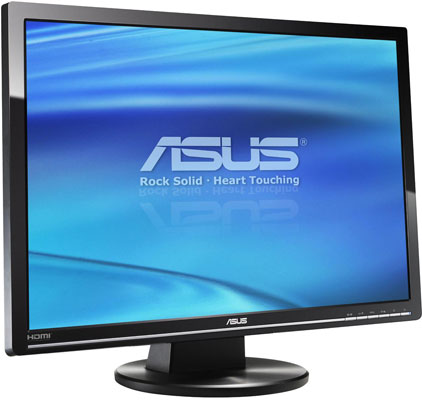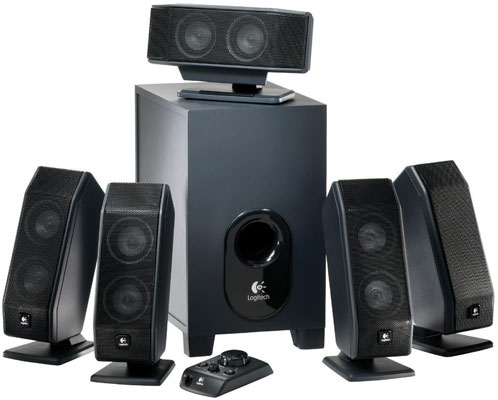System Buyer’s Guide: $1700 Performance Midrange
by Mike Jones and Jarred Walton on May 12, 2010 4:52 AM ESTMonitor, Speakers, and Input Devices
If you don’t already own these components, here are some additional peripherals to fill out your shopping cart.
| System Accessories | ||||
| Hardware | Component | Price |
Estimated Shipping |
Rebate |
| Display | ASUS VW266H Black 25.5" 2ms (GTG) HDMI Widescreen LCD Monitor (1920x1200) | $310 | $12 | ($30) |
| Speakers | Logitech X-540 70 watts 5.1 Speakers | $89 | ||
| Input | Microsoft Comfort Curve Desktop 2000 Black USB Keyboard and Optical Mouse – OEM | $28 | $8 | |
| Operating System | Microsoft Windows 7 Home Premium OEM 1-Pack (for System Builders) | $100 | ||
For an LCD, you could do a lot worse than the 25.5 inches of 2ms, 1920x1200 real estate offered by the ASUS VW266H. ASUS continues to build quality LCDs and includes HDMI connectivity (if not cables) at surprisingly low price points. Currently priced at $310 ($280 after mail-in rebate), the VW266H offers crisp images, good colors, D-Sub, DVI, HDMI, and component connectors, as well as an SPDIF out. It doesn’t include an HDMI cable, but for a monitor of this size at this price it’s difficult to complain.

Stepping down to 23” 1080p can save $100 or more and allows you to choose between several 23” 1080p displays. The ASUS VH236H is an attractive option, offering performance and connectivity on par with its larger sibling, and is currently available for $200 ($180 after $20 mail in rebate). Acer’s popular and well-regarded 23” P235Hbmid is another compelling option at the $200 price level, and it even includes an HDMI cable. If you’re really looking to shave off a couple of extra pennies, you can purchase the 21.5” 1080p ASUS VH222H for $170 ($160 after $10 mail in rebate), which is similar to the 23” version in every respect except for size.
All of the above offer great blends of value and performance, along with excellent connectivity. While you can certainly find less expensive 23” or 21.5” monitors, most will not include an HDMI connector, and you will want to be sure to research any bargain monitor whose price seems too good to be true. As the adage suggests, more often than not, “you get what you pay for.” Note that all of the displays are also TN panels, which work well enough for most users but certainly won't surpass quality IPS displays. If you want an IPS display, expect to pay around twice as much as the TN panels for a similar size display.

As the “speakers” included with most monitors are jokes no one seems to find particularly funny, it is difficult to recommend using them for anything other than a bargain basement machine. They certainly have no place in the sound system of a performance midrange machine. For a 5.1 system, the 70 Watt Logitech X-540 will definitely get the job done nicely, especially when you consider its $89 price tag. It won’t be mistaken for an audiophile grade rig, but it’s a great fit for gaming surround sound without breaking the bank. Logitech also offers a more robust 505 Watt system, but at $377 the THX-certified Z-5500 is difficult to recommend for a midrange system. As an aside, there is a disappointing lack of quality surround sound systems available in the $100-$350 price range, which makes it difficult to recommend other options.
There are many options in 2.1 systems, however, and it shouldn’t be hard to find something that will sound nice and fit your budget. The 200 Watt, THX Certified Logitech Z-2300 is a popular choice among system builders, and offers a loud (120 watts RMS) subwoofer. At $150, it offers a good mix of performance and price. The Creative Inspire T3130 2.1 speakers are a considerably less expensive option, though at $50 they are of course somewhat less robust (20 Watts total). Just the same, they will be a vast improvement over any speakers that come in the same box as your monitor.
For input devices, the Microsoft Comfort Curve Desktop 2000 fits the bill as the old standby. The keyboard is fine and, if you have no intention of gaming, the mouse will suffice for basic computing tasks. However, someone building this machine—and spending over $300 on a graphics card—probably intends to game with it. If that same someone doesn’t already have a gaming mouse they love, the Logitech MX518 is a popular option and at $43 won’t kill the bankroll. It features eight programmable buttons, custom sensitivity settings, and delivers 1800 dpi resolution. A slightly more upscale option is the Logitech G500, which costs $57, features 10 buttons, a dual-mode scroll wheel, resolution up to 5700 dpi, and the ability to adjust its weight to your preference.










102 Comments
View All Comments
GullLars - Wednesday, May 12, 2010 - link
So using your own estimation, the optimal load for a PSU is rougly 75%, lower means cooler and more silent but less efficient.The build in question has full load peak power draw roughly 350W from the wall socket. Idle likely under 100W.
750W: optimal efficiency at 750*0,75 = 562W, overshooting by 562/350=1,6x=60%
idle load: <100/750 = 13%, wastefull?
500W: optimal efficiency at 500*0,75 = 375W, overshooting by 375/350=1,06=6%, close to optimal.
idle load: <100/500 = 20%, less wastefull yet still cool at idle fan speed?
Exodite - Wednesday, May 12, 2010 - link
Actually it's even less than that as the rated wattage and load level refer to output wattage and load, not input wattage.JarredWalton - Wednesday, May 12, 2010 - link
And despite all this discussion, we already mentioned the potential to downgrade the PSU on page 4:" Those looking to run a lower spec PSU with a single GPU will be fine with the little brother of our recommended PSU, the CORSAIR CMPSU-400CX 400W. Priced at $50 (with a $10 MIR), it should be more efficient when your system is idle while still providing enough juice for the 5850. If you are thinking about going the Clarkdale route and/or a less powerful GPU, then we'd definitely recommend the 400W PSU as a more sensible choice. Just don't try running SLI/CrossFire setups."
Jediron - Tuesday, May 18, 2010 - link
Yes, and the 400watt is only just enough and leave hardly any room for future singlecard upgrades, or a few harddisks for a raid mode. Around 500watt would be optimal for this config and a single videocard.aftereview - Wednesday, May 12, 2010 - link
Normally power supply efficiency is rated at close to full load. This means running a power supply outside that range is actually less efficient.At a lower load although it will draw less power and generate less heat in an absolute sense, it will draw more power and generate more heat PER watt.
Now take a 750W and a 500W (similar design) both running at say 400W, generally the 500W will be more efficient, thus draw less and run cooler.
More is better is not necessarily true and too many people seem to forget that.
Your math is correct but the basis for your conclusions is not.
A power supply should be rated to cover the Peak power of the system with a continuous rating close to that of the system.
The power supply chosen for this article happens to have a 80plus rating at 20%, 50% and 80% load (mfg. spec.) which definitely make it suitable for the built. As some other people pointed out, a less expensive unit/lower power would work as well.
JarredWalton - Thursday, May 13, 2010 - link
Some of what you say is actually incorrect. At pretty much any load, a 750W PSU will be quieter than a 500W PSU, because it's not reaching the limits of its design. Also, at 400W load, the 750W will be in the range of maximum efficiency (using 53% of its rated output) while the 500W will be heating up more and running at lower efficiency (80% of maximum output). The 80Plus specs maximum efficiency at 50% load, and while the 500W will be more efficient at 100W loads, once you get to 350W the 750W will be more efficient (unless you're comparing a crappy 750W to a good 500W of course).Also note that at idle power draw of around 100W (give or take), the 500W at 80% efficiency would be using 125W; if the 750W is 70% efficient, it's using 142W. Bump power draw up to 400W and if the 500W is now 82% compared to 85% you're looking at 488W vs. 470W. Basically, you're trading lower power draw at idle for higher power draw at load. But you'll also have a noisier system at load with the 500W, as all PSUs pretty much start ramping fan speed quickly beyond 50% load.
So given the choice, I'd stick a 750W into an upper midrange system, simply because it runs quieter and leaves room to grow (i.e. a second GPU could be added). But, if you know you're never going to add a second GPU or heavily overclock I'd stick with a 500W (as recommended in the text).
Jediron - Tuesday, May 18, 2010 - link
-This system eats aorund 300, not 400watt.-A good psu can cope with a littel heat
-at 300 watt, the 500watt also makes hardly more noise
Three invalid arguments in a row. Need i say more.
Jediron - Tuesday, May 18, 2010 - link
I mean your arguments, not mine.Yours are flawed, based on 400watts at load.
Jediron - Tuesday, May 18, 2010 - link
No, good psu ramping up around 60/70%. Besides, that's what a fan is for, spinning. Noise become nasty, around or above 80%. Below that, most good psu's stay very silent.Futhermore, often you will not even notice it while alot of people are a playing a game at that point and
you can imagine what makes the most noise....
GullLars - Wednesday, May 12, 2010 - link
Like my subject title saysI'm so upset now i find it physically challenging to sit still and type.
WHY ON EARTH do you not include an SSD in a $1500+ build in 2010??? But you include BluRay???
Sollution #1:
Remove Bluray, add random dvd burner (if needed) and an Intel x25-V for OS + core apps.
This will roughly double the PCmark vantage score of the machine, and make a serious increase in value.
Sollution #2:
Remove Bluray, downgrade from 5850OC to 5830 (or 5770 for "good enough" instead of best graphics), add random dvd burner (if needed) and an Intel x25-M G2 80GB for OS + apps. This give much greater value, as the 5830 can run all the same games at a slightly lower framerate for $100 less, possibly with a step down in resolution or particle/HDR/texture/AA/AF.
I will speculate the only reason this article got posted and not corrected in the editorial is because Anand is out of the country. I am seriously disappointed such an article was posted on Anandtech.